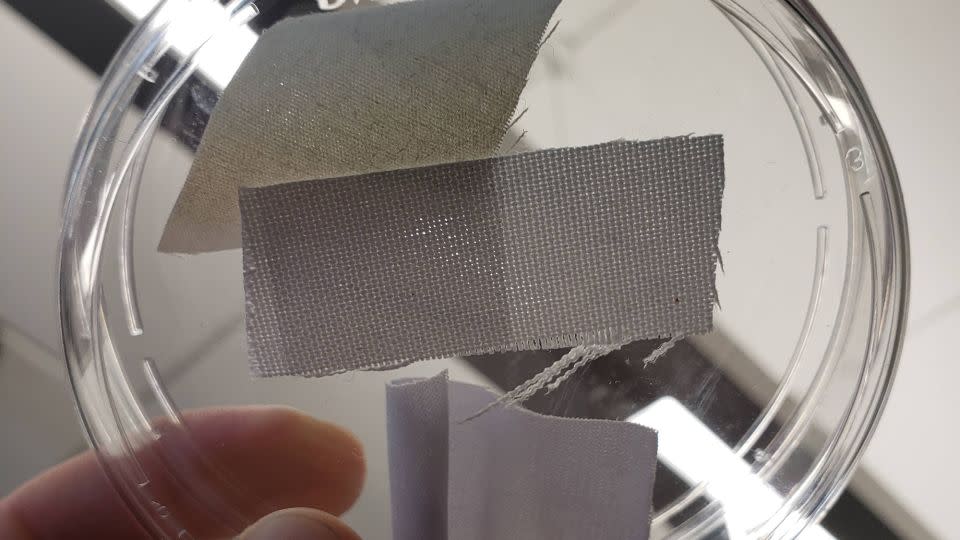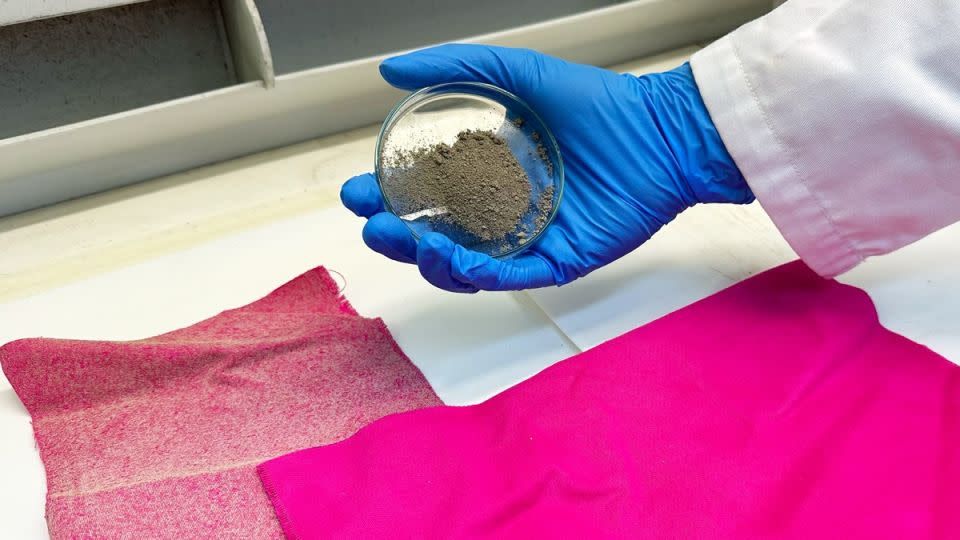Spending time outside during a heat wave can be sweaty, uncomfortable, even health-threatening, but scientists have discovered an innovation they say could provide relief: clothing that physically cools the body.
Researchers at the University of Massachusetts Amherst have developed a flexible, chalk-based coating that can be added to fabrics. During summer heat tests, they found that it reduced the temperature under clothing by up to 8 degrees Fahrenheit compared to the air, and up to 15 degrees compared to untreated fabrics.
This innovation is one of several efforts to turn people’s clothing into a tool against extreme heat, which is intensifying as people continue to burn planet-warming fossil fuels. Heat is the most debilitating type of weather, causing heat exhaustion and even heat stroke, a potentially fatal illness where the body loses the ability to cool itself.
UMass researchers say they wanted to develop a way to cool fabric using an environmentally benign material. Inspired by traditional limestone plasters used to cool houses in hot climates, they coated fabric tiles with particles of calcium carbonate – the main component in limestone and chalk.
The shield was able to reflect the sun’s energy back into the atmosphere, as well as allowing the wearer’s natural body heat to escape, according to their new study, currently under peer review, submitted to the Chemical Society America this month.
“We start with your cotton T-shirt … and we just apply this coating to one or both sides of the fabric,” Trisha L. Andrew, a chemist and materials scientist at UMass, told CNN. “The shield is completely surface level. It doesn’t penetrate or alter the cotton fibers,” she said.
The coating can be applied to almost any commercially available fabric and can also be put through the washing machine, the scientists say.
“With no power input, we are able to reduce how hot a person feels, which can be a valuable resource where people are struggling to stay cool in very hot environments,” Evan Patamia, a graduate student at UMass who worked on the innovation. , said in a statement.

Cooling fabrics are not a new invention, but past designs often involved rigid structures, complex manufacturing processes and electrical components, according to a 2023 scientific review of cooling fabric research, making them uncomfortable to wear and expensive.
The UMass development is part of a growing body of research exploring cheaper, more convenient and scalable alternatives as the threat of extreme heat around the world increases.
Scientists at RMIT University in Melbourne, Australia used tiny particles called nanodiamonds to coat cotton fabric, which led to a temperature drop of up to 3 degrees Celsius (5.4 Fahrenheit) compared to untreated cotton, according to a recent study .
This may not seem huge, but it makes a “difference in terms of comfort and health impacts over long periods, and in practical terms it could be the difference between keeping the air conditioner off or turning it on ,” Shadi Houshyar, project leader and senior lecturer. at RMIT, it said in a statement.
An RMIT University study found that the use of cooling fabrics could lead to energy savings of 20 to 30% due to lower use of air conditioning, a cooling tool that pollutes the climate greatly.
Nanodiamonds may sound expensive, but researchers say they are not the same as the diamonds used in jewelry. “They’re cheap to make,” Houshyar said.
There are still improvements to be made, she said. For example, they found that the effectiveness of the nanodiamond fabric decreased after repeated washing of the fabric.


The nanodiamonds work in a similar way to the limestone particles used by UMass, Houshyar told CNN. The principle of these studies is the same, she said, using nanoparticles to transfer heat from the body.
Houshyar – who has researched protective clothing for more than a decade – said the production process used by UMass was promising but they would have to work out how to scale it up while keeping costs low.
Cooling fabrics must be affordable, she said. “If the cost is three times the cost of the normal fabric, it’s not enough for everyone to use it.” The poorest are often among the most vulnerable to extreme heat and have the least access to cooling technologies.
As more products enter the market, there is “a lot of opportunity in this area to scale it up to make it available to everyone,” Houshyar said.
Andrew from UMass said her team has been limited until now because of the size of their lab equipment. Through a new startup company, however, they aim to begin pilot production, making sheets of treated fabric that are 5 feet wide and 300 feet long.
The costs of the raw materials for the coating are “low and manageable,” Andrew said, but he assumed the overall price would increase slightly because of the application process, in which the coating is applied to the fabric.
If production of affordable cooling fabrics can be scaled up further, some researchers say the benefits could extend well beyond clothing.
Scientists at the University of Chicago hope their cooling fabric, made from materials including silver nanofibers and wool, could also be used to cool buildings and cars. In tests under the fierce Arizona sun, they found the fabric stays 16 degrees Fahrenheit cooler than commercial silk fabric often used in summer clothing.
More widespread use of cooling fabric would reduce the costs and climate impact of air conditioning, the scientists said. “Our civilization uses about 10 to 15% of the total energy to make ourselves feel comfortable wherever we go,” Po-Chun Hsu, a University of Chicago molecular engineering professor and study author, said in a statement.
While tackling extreme heat means rapidly reducing the burning of fossil fuels, there are already deadly heat waves here, and some scientists believe these cooling fabrics could play a useful role as more people are exposed to heat and their bodies can struggle to endure.
“Personal cooling textiles show great promise in combating heat impacts associated with climate change,” Xueping Zhang, a professor specializing in personal thermal-humidity management at Donghua University, China, who authored a review, told CNN scientific 2023 on cooling. fabrics.
They can “provide localized cooling to specific body regions with high precision,” she said, and can be adapted to different environments.
She sees a large-scale role for cooling fabrics – and soon. “With the advancement of materials and technology, personal cooling textiles () will be available to the general public in the near future.”
For more CNN news and newsletters create an account at CNN.com